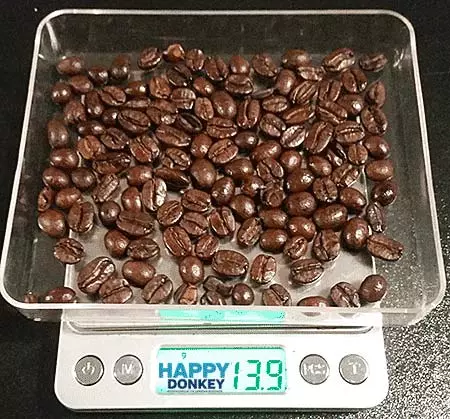Estimated reading time: 3 minutes
Table of contents
Using coffee scales is something I have done every day for the last 5 years. Possibly longer. Time flies past so quickly and it’s hard to believe Happy Donkey started as an internet only coffee company in 2004. That seems like such a long time ago now.
Looking down at my coffee scales I realise what great friends they have been. On and off several times at least, every day for so long. I have often spilt water on them and despite not being waterproof they have carried on regardless. Most recently I have used them for making filter coffee.
Today I was unable to find anything to place on the scale. I decided to weigh the beans directly onto the coffee scales platform. As I did my thoughts turned dark. What if the battery died on the scales? What would I do?
Would I go to the shops and get another battery? What if when I opened the door there stood an 8 foot snow drift, or a large hungry bear? Exactly, I would need to improvise.
Alternatives to using coffee scales.
Of course there are ways round this as we all know. For instance we can go ahead and grind fresh coffee beans, then filling the basket to the top. If we are making espresso that is.
For many years I did exactly that and sometimes still do. As do many tens of thousands across the coffee universe. It remains my favourite way of making coffee.
Another way though would be to count the beans. Of course one would have to know what each coffee bean would weigh. In advance of the battery failure.
Counting coffee beans
I set about weighing individual beans. It is here I realise the weakness of the scales. Whilst they register the weight of each beans when added to say 10G on the scales. When added to zero the scales do not respond so well.
To get round this problem I add groups of beans together on the coffee scales. This works well. Starting with the Happy Donkey Classic Italian blend we meet variables. This blend is made up from three separate Arabica beans and one Robusta bean. Extra, extra read all about it.
The coffee beans vary in size and consequently in weight. This was the same for Happy Donkey Brazilian coffee beans. Again another four bean blend !
Where things evened out was with the Cost Rica and the Sumatran Mocha. These are two I nearly always weigh out religiously. But they are easier to work with in terms of weighing. This is because the beans are a bit more uniform in size and therefore weight.
When coffee scales go wrong – Conclusion
Counting beans is challenging, I did a lot of it for this article, never again though !
Working with different sizes is not practical. For emergency situations the best thing to do is pick the larger beans out of the bag.
On average 12 large beans will weigh 2 Grams, don’t take my word for it give it a try ! So 14 Grams of coffee is going to be around 84 beans.
If you do open the door to a hungry looking bear, shut the door. Call the authorities.
Or catapult cake onto your neighbours roof. After all a problem shared is a problem halved.

